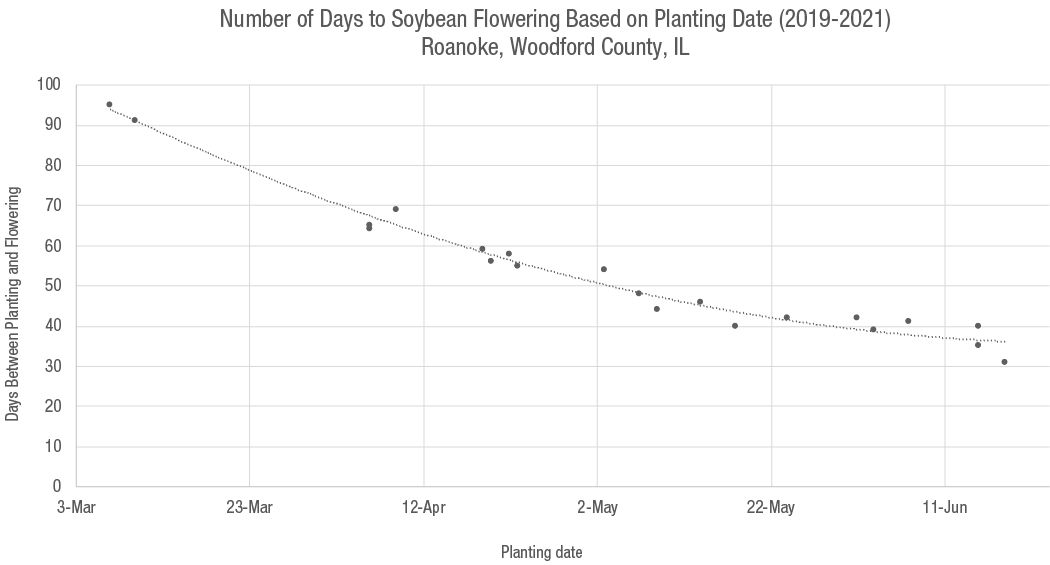10 MIN READ
Five Years of Research Evaluating the Benefits of Early Planted Soybean
March 19, 2023
Trial Objective
- Largely due to the widespread adoption of treated soybean seed, growers increasingly plant soybean earlier than in years past. For example, 41% of the Illinois soybean crop was planted by May 2, 2021, compared to the previous 5-year average of 14%.1
- This research was conducted with a goal of understanding impact of soybean planting date on yield potential and the agronomic characteristics which enable an early planted soybean crop to have higher yield potential.
- The main driver for increased yield potential in early planted soybean is the ability for the plants to create more nodes before flowering.2 To better understand this phenomenon and interaction, the number of nodes created and days to flowering were measured.
Research Site Details
- This research was conducted at Bayer Crop Science FOCUS sites in the Illinois counties of Kendall, Piatt, Sangamon, and Woodford from 2018-2022.
- Five soybean products, ranging in maturity group (MG) from 2.6 to 3.6 were evaluated; however, not all products were planted at every location or in every year.
- All seed was treated with Acceleron® Seed Applied Solutions Standard and ILEVO® seed treatment.
- Standard fertility and weed management practices were followed, and plots were harvested as they matured.

Understanding the Results
- To compare data across years, results are presented as a percentage of the maximum for the year, location, and soybean product. The highest yields occurred with the earlier planting dates and remained similar through early May and then began a steady decline after mid-May (Figure 1).
- Although later planted soybean fields can attain satisfactory yield potential, there is much greater yield variation compared to earlier planted fields.
- Plant stands can be reduced in early planting dates, but as shown in this research, the earlier plantings can have greater yield potential than later planting dates, even with lower final populations (Figure 2).
- Soybean flowering date is influenced by daylength and is often assumed to occur on a specific date regardless of planting date; however, a combination of multiple factors influences the actual date at which flowering occurs.3 Figure 3 illustrates that the period between planting and flowering is greatly reduced when planting later.
- The earlier soybean seeds are planted, the more time they can grow vegetatively and create nodes which are the foundation for yield potential (Figure 4).

Figure 1. Average soybean yield response as a percent of maximum for location, year, and soybean product (2018-2022). Highest yields were from earlier planting dates and remained similar through early May. Around mid-May, yields began a steady decline.

Figure 2. Average plant population at seeding rate of 140,000 seeds/acre over multiple planting dates (2020-2022). Regardless of lower final plant populations, earlier seeding rates produced higher yields.

Figure 3. Number of days to soybean flowering based on planting date. As planting date becomes later, the days to flowering become less because of daylength.

Figure 4. Earlier planted soybean plants produced more main stem nodes because of the increased length of time.
Key Learnings
- Although later planted soybean crops can attain satisfactory yield potential, there is greater variation than in earlier planted fields.
- Although planting earlier doesn’t always provide a yield advantage, there is rarely a yield penalty. There may be an increased risk of frost damage with early planting; however, results from our research trials indicate yield potential can be higher in earlier plantings even when some frost damage occurs.4 The ability of a soybean seedling to tolerate frost damage depends on the severity of the damage based on the below freezing temperature and how long it remains below freezing.5,6,7 If temperatures drop below 28°F, emerged seedlings can be killed.5,6,7
- To reach maximum yield potential, it is critical that seeds are properly protected with a quality seed treatment.8
- Early planted soybean plants have a longer period between planting and flowering, which can provide higher yield potential resulting from the creation of additional nodes. Conversely, later planted soybean crops have reduced time between planting and flowering, and less yield potential.
Sources:
1Illinois Crop Progress and Condition. May 3, 2021. USDA National Agricultural Statistic Service. https://www.nass.usda.gov/Statistics_by_State/Illinois/Publications/Crop_Progress_&_Condition/2021/20210503-IL-Crop-Progress.pdf
2Bastidas, A.M., Setiyono, T.D., Dobermann, A., Cassman, K.G., Elmore, R.W., Graef, G.L., and Specht, J.E. 2008. Soybean sowing date: The vegetative, reproductive, and agronomic impacts. Crop Science. Volume 48.
3Hu, M. and Wiatrak, P. 2012. Effect of planting date on soybean growth, yield, and grain quality: Review. Agronomy Journal. Volume 104.
4Should I replant my soybeans? 2021. Bayer Crop Science. https://www.corn-states.com/app/uploads/2021/12/3011_R22_21-Should-I-replant-my-soybeans_BA.pdf/.
5Nielsen, R.L. (Bob) and Christmas, E. 2002. Early season frost & low temperature damage to corn and soybean. Corny News Network Articles. Purdue University. https://www.agry.purdue.edu/ext/corn/news/articles.02/frost_freeze-0520.html/.
6Potter, B., Bongard, P., Naeve, S., and Gunsolus, J. 2018. Spring frost. University of Minnesota Extension. https://extension.umn.edu/growing-soybean/spring-frost/.
7Staton, M. 2021. Assessing frost/freeze damage to emerged soybeans. MSU Extension Soybeans. Michigan State University. https://www.canr.msu.edu/news/assessing-low-temperature-injury-to-soybeans/.
8Rees J. and Specht, J. 2020. Understanding the soybean germination process for early planted soybean decisions. CROPWATCH. University of Nebraska-Lincoln. https://cropwatch.unl.edu/2020/understanding-soybean-germination-process-early-planted-soybean-decisions/.
Web sites verified 2/8/23.
1310_193935